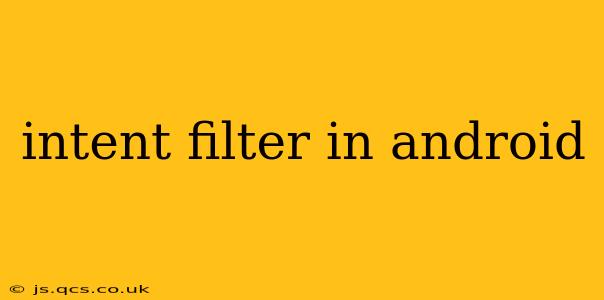Intent filters are a fundamental aspect of Android development, acting as the gatekeepers of inter-component communication. They define the types of intents that a component (like an Activity, Service, or BroadcastReceiver) can respond to. Understanding intent filters is crucial for building robust and interconnected Android applications. This comprehensive guide will explore intent filters in detail, answering common questions and providing practical examples.
What is an Intent Filter in Android?
An intent filter is a declaration within an AndroidManifest.xml file that specifies the types of intents a component can handle. It acts as a filter, allowing only intents matching its criteria to reach the component. Without an intent filter, a component can only receive intents explicitly addressed to it. Intent filters enable components to be discovered and invoked implicitly – meaning without directly naming the component. This is vital for features like opening a URL in a browser or sharing content via various applications.
How Do Intent Filters Work?
Intent filters operate by examining the intent's various attributes:
- Action: Specifies the general action being performed (e.g.,
ACTION_VIEW,ACTION_SEND,ACTION_CALL). - Data: Specifies the data being acted upon, including MIME type and URI. For example, an image viewer might specify a
image/*MIME type. - Category: Adds additional context to the intent (e.g.,
CATEGORY_BROWSABLE,CATEGORY_LAUNCHER).CATEGORY_LAUNCHERis essential for activities that appear in the app launcher. - Type: (Often used instead of data's MIME type) Explicitly states the data type.
The system matches the intent against the filter's criteria. If a match is found, the component is considered a potential handler. The system might present the user with a choice of multiple suitable components (like selecting which app to open a URL with).
What are the Different Types of Intent Filters?
While there isn't a formal classification of "types," intent filters can be categorized based on their intended use:
1. Implicit Intent Filters: Enabling Component Discovery
These are the most common type. They allow a component to respond to intents without being explicitly named. They are defined within the <intent-filter> tag in the AndroidManifest.xml. For example, a web browser might have a filter to handle ACTION_VIEW intents with data of type http or https.
2. Explicit Intent Filters: Directly Addressing Components
These are used when you want to target a specific component. While not strictly "intent filters" in the same way as implicit filters, they are relevant when considering intent handling. They directly specify the component's class name within the intent.
How to Create an Intent Filter?
Creating an intent filter involves adding <intent-filter> elements within the <activity>, <service>, or <receiver> tags in your AndroidManifest.xml. Here’s an example for an activity that handles viewing web pages:
<activity android:name=".MyWebActivity">
<intent-filter>
<action android:name="android.intent.action.VIEW" />
<category android:name="android.intent.category.DEFAULT" />
<category android:name="android.intent.category.BROWSABLE" />
<data android:scheme="http" />
<data android:scheme="https" />
</intent-filter>
</activity>
This filter specifies that MyWebActivity can handle VIEW actions, is the default activity for these actions, is browsable, and handles http and https schemes.
How to Use Intent Filters with Different Intent Components?
Intent filters work similarly across different components:
Activities: Launching Activities Implicitly
Activities frequently use intent filters for implicit invocation, like opening URLs or sharing data.
Services: Handling Background Tasks
Services can utilize intent filters to respond to specific events or requests.
Broadcast Receivers: Listening for System Events
Broadcast receivers heavily rely on intent filters to register for system-wide broadcasts, such as network changes or battery low events.
What are Common Mistakes When Using Intent Filters?
- Overly Broad Filters: Defining filters that are too general can lead to unexpected behavior or security vulnerabilities. Be specific with your actions, data types, and categories.
- Missing Categories: For activities launched from other apps, including
CATEGORY_DEFAULTis crucial. - Incorrect MIME Types: Specifying the wrong MIME type will prevent your component from handling the relevant data.
- Conflicts with Other Apps: If multiple apps have similar filters, the system might prompt the user to choose, which could lead to a less smooth user experience.
Why Are Intent Filters Important for App Security?
Well-defined intent filters are crucial for security. Overly broad filters can leave your app vulnerable to attacks. By carefully specifying which intents your components can respond to, you reduce the attack surface and protect user data.
This detailed guide offers a solid foundation for understanding and effectively implementing intent filters in your Android applications. Remember to always prioritize clarity, specificity, and security in your filter definitions.
